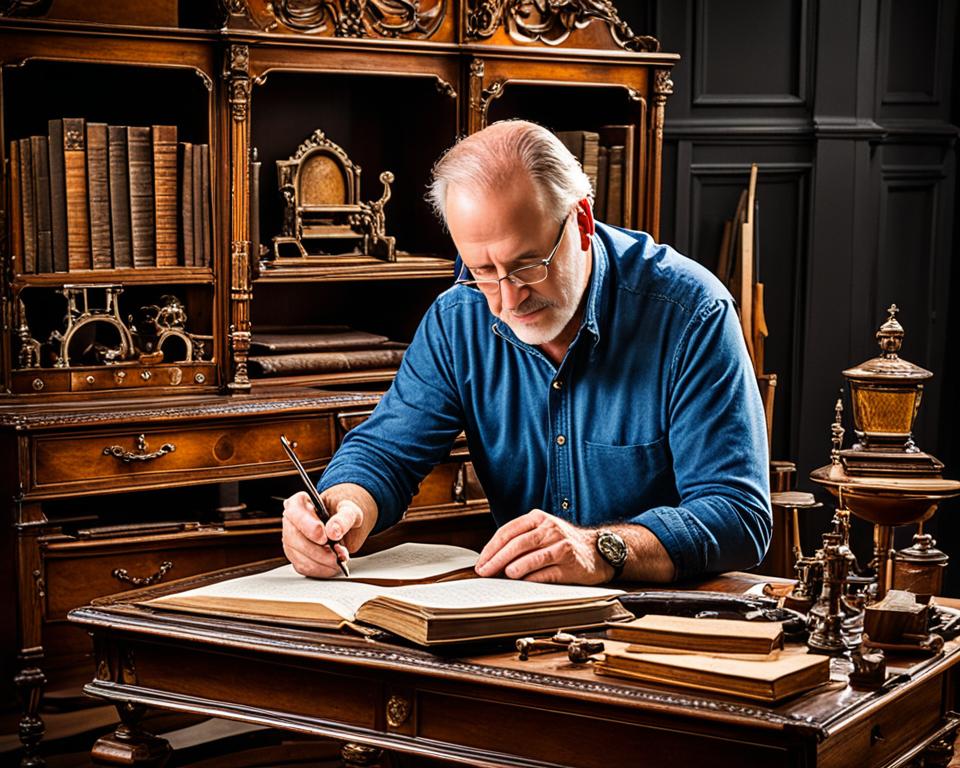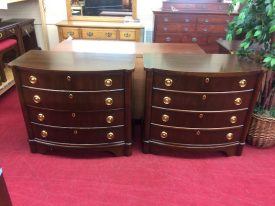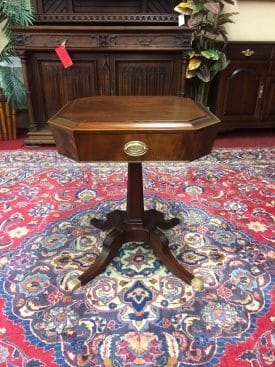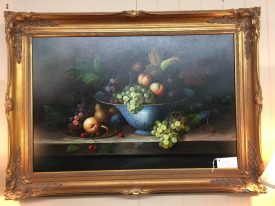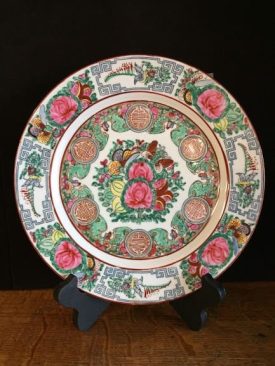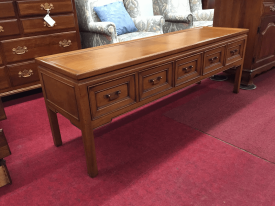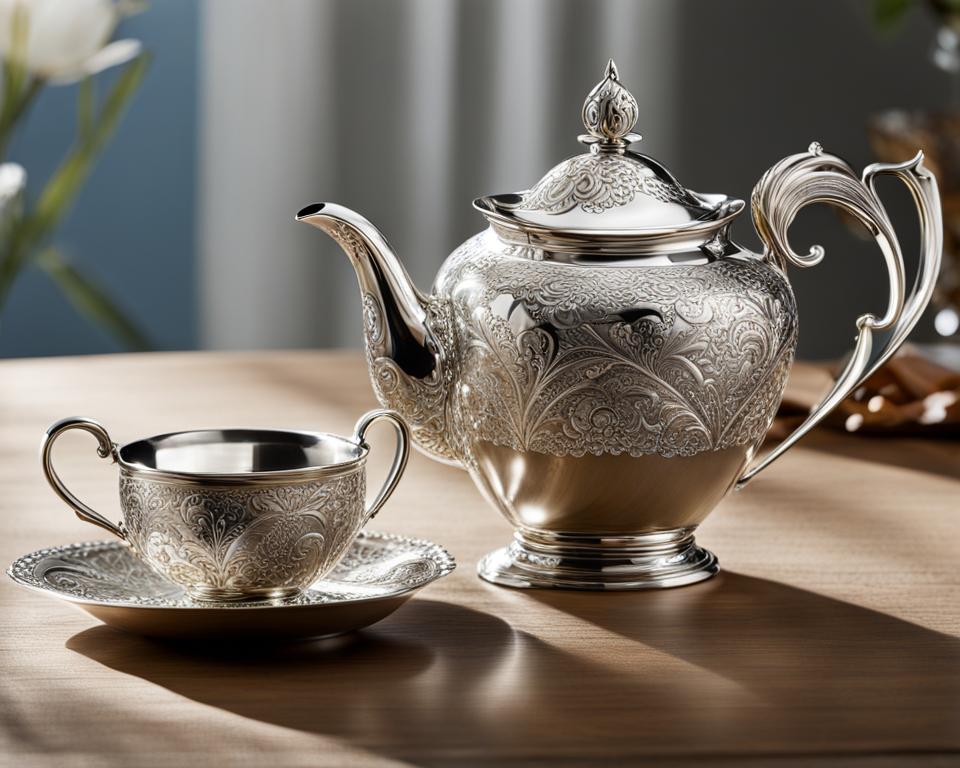Valuing antique furniture can be a challenging task, but with the right knowledge and approach, you can accurately determine the worth of your vintage pieces. In this article, we will provide you with expert tips and step-by-step guidance on how to assess and evaluate your antique furniture accurately.
Key Takeaways:
- Examine the furniture carefully, taking note of style, unique features, and any labels or markings.
- Identify the type of wood used in the furniture to gain insights into its age and potential value.
- Avoid handling or attempting any cleaning or repairs before determining the value to prevent devaluing the furniture.
- Understand the different types of antique furniture values, such as fair market value, wholesale value, and auction value.
- Conduct thorough research on vintage furniture values using online resources, books, and comparisons.
Examine the Furniture
Before determining the value of your antique furniture, it’s crucial to carefully examine each piece. By paying attention to its style, class, and unique features, you can gather valuable insights into its origin and potential worth.
Start by looking for labels or markings that might provide information about the manufacturer or the period in which it was made. This can give you important clues about the furniture’s authenticity and historical significance.
Assessing the condition of the furniture is equally important. Look for any damages, repairs, or alterations. Are there visible signs of wear and tear? Has the piece been modified in any way? Identifying these aspects will help you gauge the overall quality and preservation of the furniture.
A deep understanding of vintage furniture features is essential for accurate valuation. Take note of any distinctive elements that make the piece stand out, such as decorative embellishments, unique joinery techniques, or specific design characteristics. These features can significantly impact the value of the furniture.
To illustrate the importance of examining furniture features, here’s an image showcasing the intricate carvings and ornate details found on a vintage dining table:
A Sample Table to Highlight Key Features of Antique Furniture:
| Feature | Description |
|---|---|
| Carvings | Intricate detailing on legs, corners, or tabletop. |
| Joinery | Visible dovetail, mortise, or tenon joints. |
| Ornamentation | Embellishments like inlays, marquetry, or brass accents. |
| Hardware | Ancient hinges, pulls, or knobs distinctive to a certain period. |
| Proportions | Harmonious dimensions based on historical design principles. |
By meticulously examining your vintage furniture and understanding its unique features, you’ll be equipped to make informed decisions when it comes to valuing and appraising your antique pieces.
Identify the Type of Wood
The type of wood used in antique furniture can provide valuable insights into its age and potential value. By identifying the specific type of wood, you can better understand the historical context and significance of the piece. Native timbers like beech, elm, yew, and ash are commonly used in the crafting of antique furniture, showcasing the skilled craftsmanship and natural resources available during different periods of history.
During the 16th and 17th centuries, oak was a popular choice for furniture, known for its durability and distinctive grain pattern. Oak pieces often feature intricate carvings and ornate details, reflecting the craftsmanship of that era. As time progressed, other types of wood gained popularity. Walnut, with its rich, dark color and straight grain, became fashionable during the 18th century. Mahogany, known for its deep reddish-brown hue and fine texture, was widely used in furniture making during the 18th and 19th centuries.
In the later eras, exotic woods such as satinwood and rosewood were favored for their unique and luxurious appearance. Satinwood, with its bright yellow color and smooth texture, became popular during the late 18th and early 19th centuries. Rosewood, prized for its rich, dark reddish-brown color and intricate grain patterns, was commonly used in the 19th century. By understanding the types of wood associated with different periods, you can gain valuable insights into the age and potential value of your antique furniture.
Antique Furniture Wood Types
| Wood Type | Characteristics | Period |
|---|---|---|
| Oak | Durable, distinctive grain, ornate carvings | 16th-17th centuries |
| Walnut | Rich, dark color, straight grain | 18th century |
| Mahogany | Deep reddish-brown hue, fine texture | 18th-19th centuries |
| Satinwood | Bright yellow color, smooth texture | 18th-19th centuries |
| Rosewood | Rich, dark reddish-brown color, intricate grain | 19th century |
Avoid Handling the Furniture Before Knowing Its Worth
When you come into possession of antique furniture, it’s important to resist the temptation to handle, clean, or repair it before determining its value. Handling the furniture without a proper understanding of its worth can potentially devalue it, affecting its resale potential. Instead, seek the guidance of a reliable appraiser or antique dealer who can provide valuable insights on the best ways to preserve, clean, and repair your antique furniture without compromising its value.
Preserving antique furniture requires a delicate approach to protect the integrity of the piece. The following precautions should be taken:
- Avoid harsh cleaning agents: Use gentle cleaning solutions specifically designed for antique furniture to avoid causing any damage or discoloration.
- Handle with care: Whenever you need to move or reposition the furniture, make sure to handle it with extreme care to prevent accidental damage.
- Protect from sunlight: Direct sunlight can fade and deteriorate the wood and upholstery of antique furniture. Keep the furniture away from windows or use curtains and blinds to shield it from harmful UV rays.
When it comes to cleaning antique furniture, take the following steps:
- Test cleaning products: Before applying any cleaning product to the furniture, test it on a small, inconspicuous area to ensure it doesn’t cause any adverse reactions.
- Gentle dusting: Use a soft, lint-free cloth or a feather duster to gently remove dust and debris from the surface of the furniture. Be cautious not to scratch or damage the delicate finishes.
- Address stains promptly: If you notice any spills or stains on the furniture, act quickly to remove them. Use mild soap and water or specialized antique furniture cleaners to gently clean the affected area.
Repairs and restorations should be approached with utmost care:
- Consult an expert: For significant repairs or restorations, it’s best to consult a professional antique furniture restorer who can assess the damage and perform the necessary repairs without compromising the value or authenticity of the piece.
- Use reversible methods: Whenever possible, opt for reversible methods or techniques that can be undone without causing permanent changes to the furniture.
- Document the repairs: If you do undertake any repairs, make sure to document them thoroughly, including before and after photographs. Maintaining a detailed record of the restoration process can help establish the provenance and integrity of the furniture.
By avoiding handling, cleaning, or repairing antique furniture before determining its value and seeking the guidance of professionals, you can preserve the historical and monetary worth of these valuable pieces.
Expert Tip:
“Preserving the original condition of antique furniture is vital for maintaining its value. Always remember that altering, refinishing, or repairing antique furniture should be done with extreme caution and in consultation with professionals.”
| Common Mistakes to Avoid | Best Practices for Preservation |
|---|---|
| Using harsh chemicals or abrasive cleaners | Using specialized antique furniture cleaners and mild soaps |
| Handling the furniture without care | Using proper techniques to lift and move the furniture |
| Keeping the furniture exposed to direct sunlight | Protecting the furniture from harmful UV rays |
| Attempting complex repairs without expertise | Seeking professional assistance for repairs |
Understand the Types of Antique Furniture Values
When it comes to valuing antique furniture, it’s essential to have a clear understanding of the different types of values associated with these unique pieces. By familiarizing yourself with the following terms, you can make informed decisions about buying, selling, or appraising antique furniture.
Fair Market Value
Fair market value refers to the price that a willing buyer would be prepared to pay for a particular piece of antique furniture. It takes into account factors such as the rarity, condition, and demand for the item. Fair market value can vary depending on prevailing market conditions and the specific characteristics of the piece in question.
Wholesale Value
Wholesale value represents the price at which a dealer or reseller would be willing to purchase an antique furniture item. This value is typically lower than the fair market value as it takes into consideration the profit margin that the dealer expects to make when reselling the piece.
Auction Value
Auction value refers to the range of prices at which an antique furniture piece may sell at auction. The final sale price at auction can be influenced by factors such as the level of interest from potential buyers, competition during the bidding process, and the overall condition and desirability of the item.
Understanding the different types of antique furniture values is important as it allows you to tailor your valuation approach based on your specific goals. Whether you’re looking to sell, obtain insurance appraisal, or evaluate an estate, knowing the fair market value, wholesale value, and auction value of your antique furniture piece will help you make informed decisions.
Refer to the table below for a quick summary of the different types of values associated with antique furniture:
| Furniture Value | Description |
|---|---|
| Fair Market Value | The price a buyer is willing to pay for a piece |
| Wholesale Value | The price a dealer would offer for a piece |
| Auction Value | The range at which an item may sell at auction |
Research Vintage Furniture Values
Conducting thorough research on vintage furniture values is crucial in accurately determining the worth of your antique pieces. By utilizing online resources such as databases, auction platforms, and forums, you can find valuable information on similar antique furniture and their prices. Books also provide a wealth of insights into vintage furniture values. Comparing and exploring different sources will allow you to gather a comprehensive understanding of the market, enabling you to make informed valuation decisions.
One valuable online resource for researching vintage furniture values is databases. These databases compile historical data on past sales, giving you a comprehensive view of the prices at which similar antique furniture pieces have been sold. Additionally, they often provide detailed information about the unique features and characteristics of each item, allowing you to make accurate comparisons.
Auction platforms also offer valuable insights into vintage furniture values. These platforms allow you to view ongoing and completed auctions, providing real-time pricing information. You can observe the bidding activity and final sale prices of similar furniture pieces, helping you gauge their market value.
Another useful resource for researching vintage furniture values is online forums. These platforms bring together antique enthusiasts, collectors, and experts who share their knowledge and experiences. By participating in these discussions and asking questions, you can gain valuable insights into the value of specific antique furniture pieces.
| Online Resources | Description |
|---|---|
| Databases | A compilation of historical data on past sales and prices of antique furniture. |
| Auction Platforms | Online platforms where you can view ongoing and completed auctions, providing real-time pricing information. |
| Forums | Online communities where antique enthusiasts, collectors, and experts share knowledge and experiences. |
It’s important to note that when researching vintage furniture values, it’s essential to consider factors such as the condition of the furniture, specific features or characteristics, and the reputation of the manufacturer or designer. These factors can significantly impact the overall value of the piece.
By conducting diligent research and utilizing various online resources, you can gain a comprehensive understanding of vintage furniture values. This knowledge will empower you to accurately assess the worth of your antique pieces and make informed decisions about their buying, selling, or preservation.
Continue reading to learn about the importance of expert appraisal in valuing antique furniture.
Get the Furniture Appraised
If you have doubts about valuing your antique furniture, it’s highly recommended to seek professional appraisal services. Choosing a competent and specialized appraiser is essential to accurately assess and provide a written appraisal for your vintage furniture.
Appraisers who specialize in your specific type of antique furniture have the expertise to determine its true value, taking into account factors such as age, condition, rarity, and market demand. They have access to a wide range of resources and knowledge that enable them to offer accurate antique furniture valuation.
Why Hire a Professional Antique Furniture Appraiser?
“A professional antique furniture appraiser possesses the knowledge and experience to assess your vintage pieces accurately. They are familiar with various styles, periods, and craftsmanship techniques, allowing them to provide a comprehensive and detailed appraisal.”
By hiring a professional appraiser, you can benefit from their expertise and ensure that you have an accurate understanding of the value of your antique furniture. Their appraisal will include a detailed description of the piece, its historical context, and an estimated value based on the current market.
When selecting an appraiser, consider their credentials, experience, and reputation in the field. Look for appraisers who belong to recognized appraisal organizations, such as the International Society of Appraisers (ISA) or the Appraisers Association of America (AAA).
Keep in mind that antique furniture appraisal services may involve a fee, but the investment is worth it to obtain an accurate valuation that can guide your decision-making regarding selling, insurance, or estate planning.
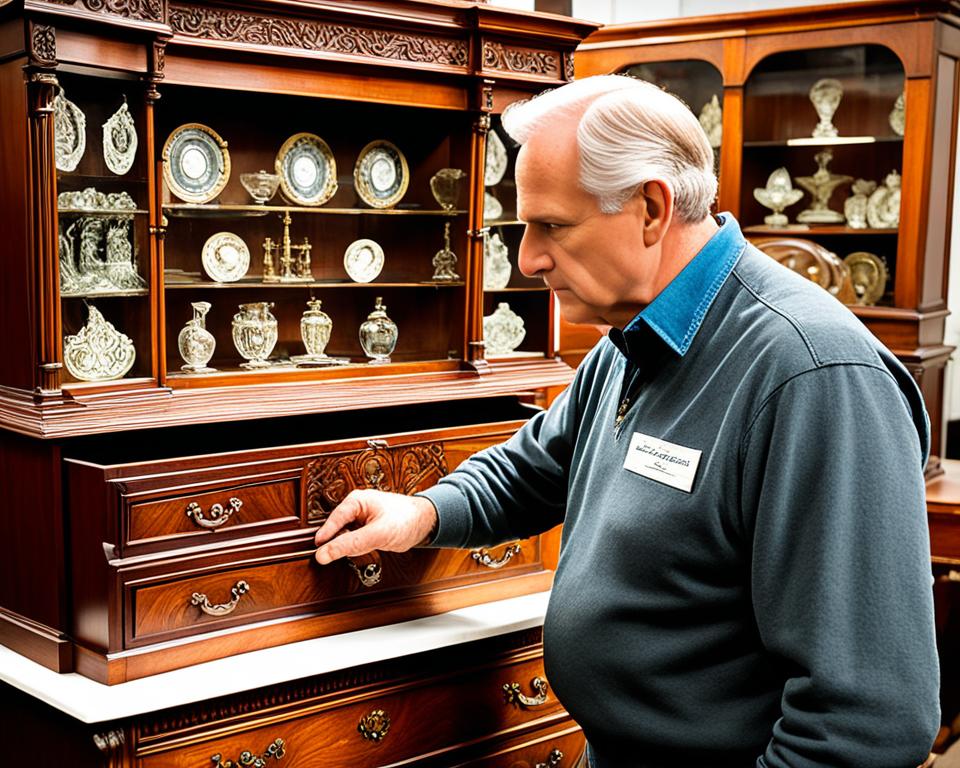
| Benefits of Professional Antique Furniture Appraisal Services | Reasons to Choose a Specialized Appraiser |
|---|---|
|
|
What to Do Next with the Appraised Vintage Item
Once you have received the appraisal for your vintage furniture, you have several options for what to do with the item. Consider the following:
- Keep it as a decorative piece: If the antique furniture holds sentimental value or complements your interior design, you may choose to keep it as a decorative piece. In this case, you can potentially insure it based on its appraised value, providing financial protection in the event of loss or damage.
- Sell the piece: If you’re looking to part ways with your antique furniture and potentially earn a profit, selling it is a viable option. You can explore various selling platforms such as online auctions, auction houses, or consignment stores. These avenues give your vintage piece broader exposure to potential buyers who may appreciate its historical and aesthetic value.
- Consider donating it: If the antique furniture no longer aligns with your lifestyle or you have charitable intentions, donating it is a generous choice. Many organizations accept antique furniture donations and use the proceeds to support their causes. Not only does this help those in need, but it also provides you with a tax deduction opportunity.
- Store it for future use: If you decide to keep the antique furniture but don’t have enough space in your current location, storing it in a facility is a practical solution. Look for climate-controlled storage units specifically designed for preserving antique furniture. This way, you can safely store your valuable piece while ensuring its protection from environmental factors like moisture and temperature fluctuations.
When determining what to do with your appraised vintage item, consider your personal preferences, financial goals, and the overall condition and significance of the furniture. Each option presents a unique opportunity to preserve, profit from, or contribute to the legacy of your antique piece.
Example Storage Facility:
| Storage Facility | Location | Features | Contact |
|---|---|---|---|
| Antique Storage Solutions | New York City, NY | – Climate-controlled units – 24/7 surveillance – Fire and burglar alarms – Inventory management system |
Phone: 555-123-4567 Email: info@antiquestorage.com Website: www.antiquestorage. |
Importance of Expert Authentication
When it comes to dealing with antique furniture, expert authentication plays a crucial role. If you find yourself unsure about the authenticity or origin of a particular piece, it’s highly recommended to consult an expert at an auction house or antiques shop. These professionals possess the knowledge and expertise needed to verify the age, provenance, and value of the furniture.
By consulting antique experts, you can rely on their extensive experience and connoisseurship to accurately authenticate and assess the worth of your antique furniture. They have the skills and resources to identify the subtle nuances that determine the authenticity of a piece, such as assessing the craftsmanship, materials used, and historical context.
Expert authentication not only provides you with peace of mind but also ensures that you are making informed decisions about your antique furniture. By verifying the authenticity of your pieces, you can confidently showcase and potentially sell them at their true value, or even include them in your estate planning.
Benefits of Expert Authentication:
- Accurate assessment of age and origin
- Verification of craftsmanship and materials used
- Confirmation of historical context and significance
- Enhanced credibility and market value
“Expert authentication is essential for accurately identifying and assessing the worth of antique furniture. Their knowledge and expertise are invaluable in determining the authenticity of a piece and can greatly impact its value.”
Whether you are a collector, curator, or antique enthusiast, consulting antique experts for authentication is an important step in the valuation process. Their trained eyes and comprehensive understanding of antique furniture can provide you with the confidence and credibility you need. So, before you make any decisions about your antique furniture, be sure to consult with the experts.
| Expert Authentication | Benefits |
|---|---|
| Accurate assessment of age and origin | Provides insights into the historical context and significance of the piece |
| Verification of craftsmanship and materials used | Enhances the credibility and market value of the furniture |
| Confirmation of historical context and significance | Avoids potential misidentification and misvaluation |
Importance of Condition and Provenance
The condition and provenance of antique furniture are key factors that can significantly impact its value. The condition refers to the overall state of the furniture, including any damages, alterations, or signs of wear. Furniture in original condition, without significant flaws or alterations, is highly desirable and can command a higher value.
Provenance, on the other hand, refers to the history of ownership and the documented background of the furniture. Antique furniture with prestigious provenance or historical significance often holds greater value in the market. The rich story behind a piece, such as being owned by a famous individual or having a connection to a significant historical event, can elevate its appeal and worth.
Impact of Condition on Antique Value
“The condition of antique furniture plays a crucial role in determining its value. Pieces that are well-preserved and in excellent condition tend to be more valuable than those with noticeable damages or extensive restoration. Collectors and buyers seek out antique furniture in original condition, as it demonstrates authenticity and showcases the craftsmanship of the era. Any signs of wear or damage should be considered when appraising the value of an antique piece.”
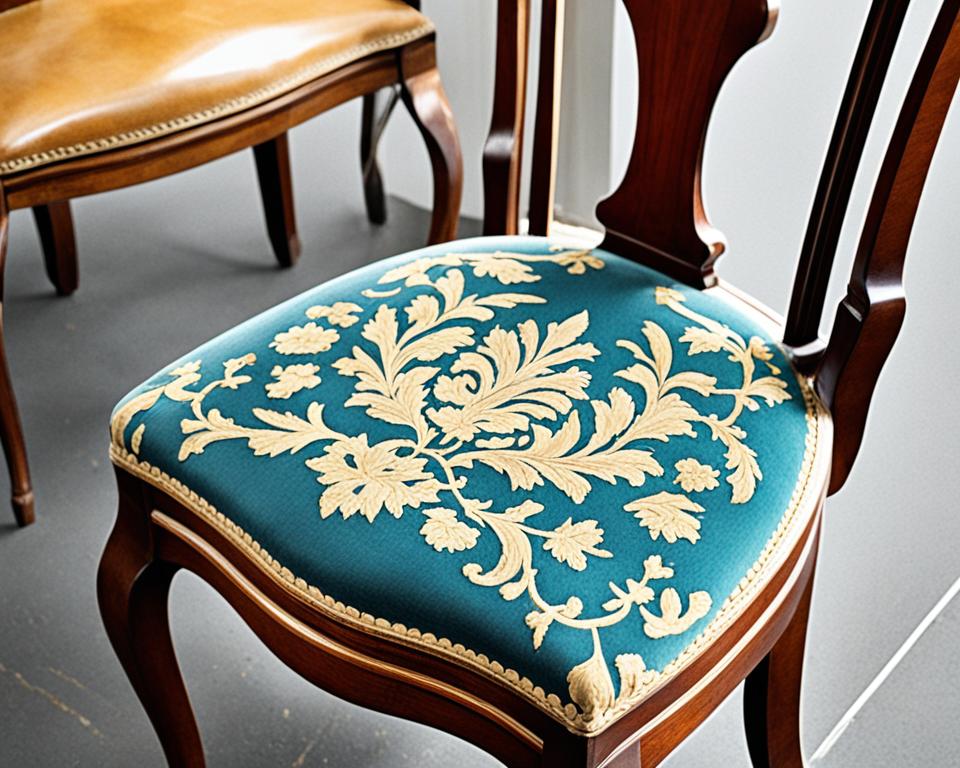
| Condition Rating | Description |
|---|---|
| Excellent | The furniture is in pristine condition with no visible flaws, damages, or repairs. It retains its original finish and shows minimal signs of wear. |
| Good | The furniture exhibits minor wear and tear consistent with its age. It may have small blemishes or repairs that do not significantly impact its overall appearance. |
| Fair | The furniture shows noticeable wear, scratches, or structural issues. It may require some restoration or repair to improve its condition. |
| Poor | The furniture has extensive damages, missing parts, or alterations that significantly affect its appearance and functionality. Restoration or repair may be necessary to restore its value. |
When assessing the value of antique furniture, it’s important to consider the specific condition and consult professionals if necessary. A thorough understanding of the furniture’s condition will help you make informed decisions and accurately determine its worth.
Importance of Provenance
“The provenance of antique furniture can greatly enhance its value and desirability. Pieces with documented histories or connections to notable events and individuals can command higher prices in the market. This historical significance adds a layer of prestige and uniqueness to the furniture, making it more sought after among collectors and enthusiasts. When appraising the value of antique furniture, exploring its provenance can provide invaluable insights into its cultural and historical value.”
Understanding the provenance of antique furniture involves conducting meticulous research, reviewing documentation, and consulting experts in the field. Auction catalogs, previous ownership records, and historical archives are valuable sources of information that can shed light on the furniture’s past. The more comprehensive and well-documented the provenance, the more impact it has on the overall value of the piece.
By considering both the condition and provenance of antique furniture, you can evaluate and appraise its value more accurately. These factors, along with other key elements like rarity, craftsmanship, and style, contribute to the overall worth of a piece in the antique furniture market.
Utilizing Auction Databases and Market Research
Auction databases and market research play a crucial role in determining the value of your antique furniture. By accessing websites such as Christie’s, Heritage Auctions, and Live Auctioneers, you can gain valuable insights from past auction results. This information allows you to gauge the market value of similar pieces and make more informed decisions about valuing your antique furniture.
Comparing recent sale prices and analyzing market trends can provide you with a better understanding of the current market value for antique furniture. Utilizing auction databases and market research helps you stay updated on pricing fluctuations and identify collectible pieces that may command higher prices. By gathering comprehensive data, you can accurately assess the worth of your antique furniture and make informed decisions about buying, selling, or insuring your valuable pieces.
“By utilizing auction databases and conducting market research, you can gain a competitive edge in the antique furniture market and confidently determine the value of your pieces.”
To showcase the significance of using auction databases and market research, let’s compare the sale prices of different antique furniture pieces over the past year:
| Antique Furniture Piece | Price Range |
|---|---|
| 19th-century mahogany dining table | $2,500 – $6,000 |
| Victorian walnut sideboard | $1,200 – $3,500 |
| 18th-century Chippendale chair | $3,000 – $7,500 |
As you can see from the table, antique furniture prices can vary significantly depending on factors such as style, condition, rarity, and demand. The data obtained from auction databases and market research can help you make well-informed decisions when it comes to buying or selling your antique furniture.
By leveraging auction databases and conducting thorough market research, antique furniture enthusiasts and collectors can confidently determine the value of their pieces and navigate the antique furniture market with ease.
Conclusion
Accurately valuing antique furniture requires a careful and systematic approach. By following expert tips and utilizing available resources, you can confidently determine the worth of your vintage pieces. The first step is to carefully examine the furniture, taking note of its style, unique features, and condition. Identifying the type of wood used in the furniture can provide valuable insights into its age and potential value. Additionally, it is essential to avoid handling or attempting any cleaning or repairs on the furniture before knowing its worth. Seek guidance from a professional appraiser who specializes in antique furniture to ensure an accurate valuation.
Thorough research is crucial in determining antique furniture worth. Utilize online resources, such as databases, auction platforms, and forums, to gather information on similar pieces and their prices. Comparing different sources will give you a comprehensive understanding of the market and enable you to make informed valuation decisions. When in doubt, seek expert authentication to verify the authenticity, age, and provenance of your antique furniture.
Understanding the true value of your antique furniture will help you make informed decisions, whether you choose to keep, sell, or donate it. Valuing antique furniture is a fascinating process that requires a mix of knowledge, research, and expert guidance. With the right approach, you can accurately assess and appreciate the worth of your vintage pieces.
FAQ
How can I accurately value my antique furniture?
To accurately value your antique furniture, carefully examine the piece, identify its unique features, assess its condition, and determine the type of wood used. Conduct thorough research on vintage furniture values and consider seeking professional appraisal services.
What should I look for when examining antique furniture?
When examining antique furniture, take note of its style, class, and unique features. Look for labels or markings that provide information about the manufacturer or origin of the piece. Assess the condition for any damages, repairs, or alterations.
How can I identify the type of wood used in antique furniture?
The type of wood used in antique furniture can give insights into its age and value. Native timbers like beech, elm, yew, and ash are commonly used, but specific types of wood may be associated with certain historical periods. Consult resources or experts to identify the type of wood in your furniture.
Should I handle or clean my antique furniture before determining its value?
It is best to avoid handling or attempting any cleaning or repairs on your antique furniture before determining its value. Consulting a reliable appraiser or antique dealer can help you assess, clean, repair, and restore your furniture without devaluing it.
What types of antique furniture values should I know?
Different types of values exist for antique furniture, including fair market value (the price a buyer is willing to pay), wholesale value (the price a dealer would offer), and auction value (the range at which an item may sell at auction).
How can I research vintage furniture values?
Utilize online resources, such as databases, auction platforms, and forums, to find information on similar antique furniture and their prices. Books can also provide valuable insights. By comparing different sources, you can gather a comprehensive understanding of the market.
Should I get my antique furniture appraised?
If you have doubts about valuing your antique furniture, it is highly recommended to seek professional appraisal services. Choose a competent and specialized appraiser who can accurately assess and provide a written appraisal for your vintage furniture.
What should I do with my appraised vintage furniture?
After receiving the appraisal for your vintage furniture, you have several options. You can keep it as a decorative piece, potentially insuring it based on its appraised value, sell it through online auctions or consignment stores, donate it, or store it in a facility for future use.
Why is expert authentication important for antique furniture?
If you are unsure about the authenticity or origin of a particular piece of antique furniture, consulting an expert at an auction house or antiques shop is crucial. Their knowledge and expertise can help you verify the age, provenance, and value of the furniture.
How does the condition and provenance of antique furniture impact its value?
Antique furniture in original condition, without significant damages or alterations, is desirable and can increase its value. Provenance, or the history of ownership, can also affect the worth of antique furniture. Pieces with prestigious provenance or historical significance may command higher prices in the market.
Where can I find auction databases and conduct market research for antique furniture?
Auction websites like Christie’s, Heritage Auctions, and Live Auctioneers provide access to past auction results, allowing you to gauge the market value of similar pieces. Comparing recent sale prices and market trends enables you to make more informed decisions about valuing your antique furniture.

